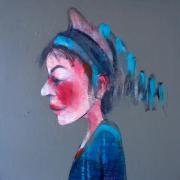
'Head to head' – an exhibition focusing upon 'the human head' – at first sounds slightly offputting. One half-expects to enter a room full of bloody spikes and grimacing decapitees. The reality – at Broughton Street's Union Gallery, at least – is very different.
By concentrating on the term head rather than face or portrait, partners Alison Auldjo and Rob Dawkins have given their four featured artists ample space in which to interpret this most celebrated and familiar human subject in unfamiliar and contrasting ways.
David Hosie's twelve female studies are flat and strangely still, and – despite their colourfulness – also devoid of that spiritual resonance which accompanies similarly restrained religious icons (see Ghanaian Girl 2, below right). Taken together, the lives of the attractive young women and two children represented lack context; their liveliness seems to be of less interest than a classificatory comparison of features. I found the effect interesting – and troubling – for the emotional distance Hosie successfully interposes between viewer and the real people pictured.[img_assist|nid=1933|title=|desc=|link=node|align=right|width=176|height=200]
Writing of previous work, he has acknowledged the deliberate nature of such effects, explaining how the 'static quality of the protagonist in the painting serves to intensify the emotional aspect to the viewer'. Well, not in my case, at least not here. If anything, Hosie's refusal to interpret or vivify rather repels me. I find myself focusing on what's absent rather than experiencing any flood of emotions surging in in to fill the vacuum. As when examining meticulously assembled collections of butterflies or geological specimens or teeth, the sensation here of emotionless comparison is only briefly diverting.
For all that, in the context of this exhibition, the inclusion and positioning of Hosie's work is a rather brilliant coup de théâtre. It is juxtaposed with the emotionally supercharged portraits of Norrie Harman, and is perhaps the only kind of work which could hold its own in such proximity. Where Hosie's output is compact, calm and disengaged, Harman's massive, brooding heads project powerful, possibly destructive emotions vigorously and physically expressed. The charcoal-and-pencil violence with which they are realised on the paper, and the illusion of dark three-dimensionaity, are highly affecting.[img_assist|nid=1936|title=|desc=|link=node|align=right|width=439|height=640]
Harman understands his subjects' barely contained energy, reads the suppressed pain or anger behind their eyes. J. Gaunt has written of Harman's work that 'He is interested in displacement, people on the edge of society, the fringes, outcasts. He paints discarded places and discarded people.'
What is moving is that whilst acknowledging forms of exclusion – colour, criminality, sociopathy – Harman celebrates the inextinguishable human spirit within. As viewers, we therefore find ourselves on both sides of the equation – observer and object, judge and accused. In addition to its technical excellence and emotional forthrightness, his work throws up really interesting and uncomfortable questions about how society works and in whose favour.
My favourite of his drawings was Boy from Lagos (shown above), a work whose presence dominates the viewer and the gallery space from the rear wall for the duration of any visit.
Utterly different are Sophie McKay Knight's playful enigmas. These mixed-media combinations of painting, printmaking, drawing and text are highly narrative – the tales they allude to drawn from personal experience, history or myth. 'I am very interested in storytelling,' she writes, 'everyday magic, and the blurring of zones. Other things which inspire me are memory, reflections, imprints and history – things which I believe can survive through time.'
The resulting palimpsests are visually pleasing and thoughtfully intriguing. Some comprise an ironic interaction between title and image, as in Mirror Mirror on the Wall (pictured top-right). Others to my mind – without the painter's personal interpretation – would be decorative but beyond decoding.
[img_assist|nid=1935|title=|desc=|link=node|align=right|width=374|height=640]Finally, the exhibition features work by Joyce Gunn Cairns, an unconventional champion of the unconventional. Repelling all attempts to crudely define her voice, her political, religious or sexual identity, her starting point is her 'own middle-aged body'.
An end point would suggest a possibility of fixity, of resolution and definition, and so it is for this reason, I suspect, that so many of her figures appear unresolved, in the process of melting, changing, dissolving or becoming (see Chrysalis, right). Her characters avoid the constraining syntax of eye contact, their features and shapes are in motion.
Highly interesting, beautifully wrought, subtly composed and coloured: Cairns's paintings are a heartening affirmation of lived realities beyond simplistic categorisation. AM
'Head to Head' runs from at the Union Gallery (34 Broughton Street) until 1 August.